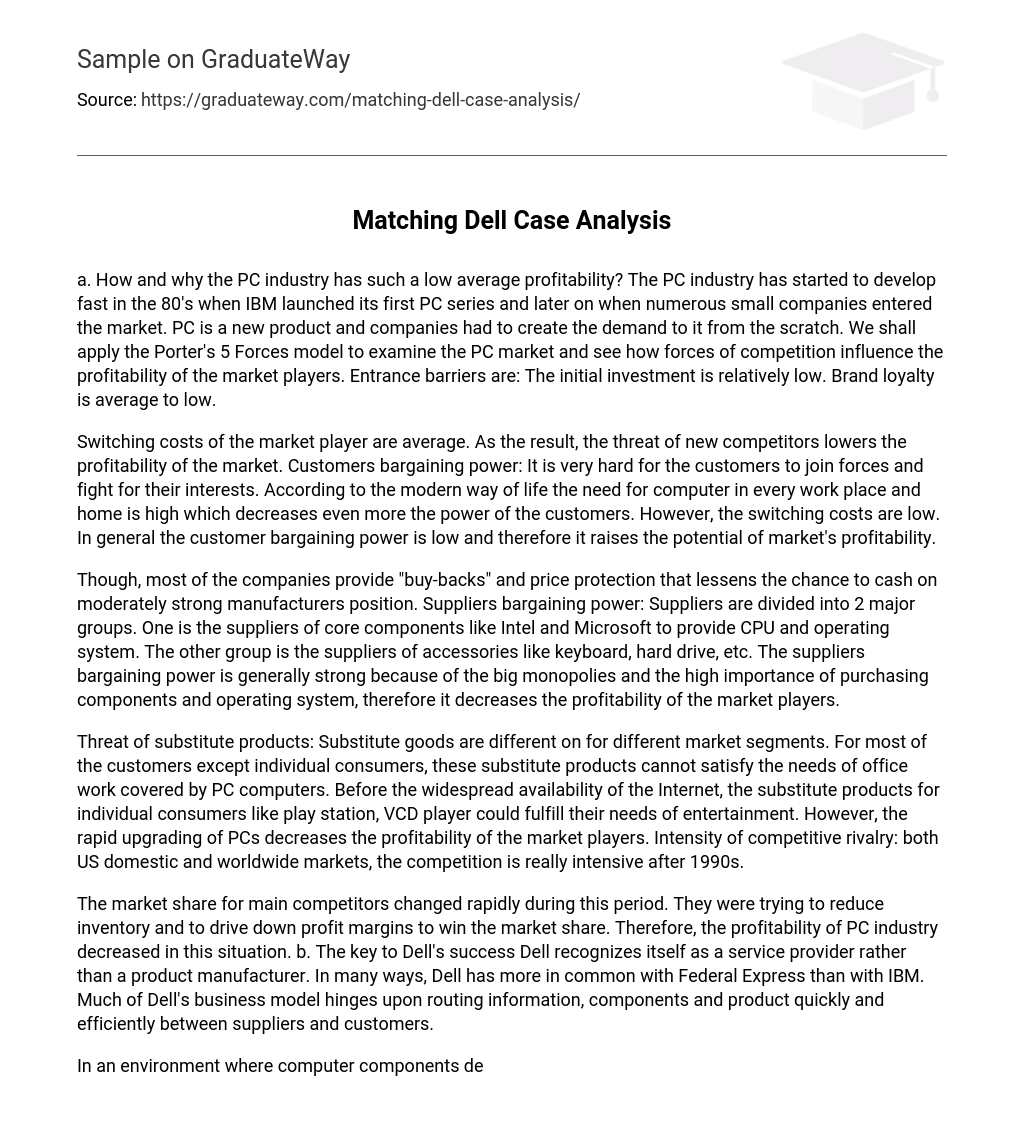a. The PC industry has a low average profitability due to various factors. The industry experienced rapid growth in the 80’s with the introduction of IBM’s first PC series and the entrance of many small companies. As a new product, companies had to create demand from scratch. To analyze the PC market and its impact on profitability, we will use Porter’s 5 Forces model. The entrance barriers are relatively low initial investment and average to low brand loyalty.
The market player has average switching costs, which reduces the market’s profitability by making it less attractive for new competitors. However, customers find it difficult to unite and advocate for their interests, as the demand for computers in both workplaces and homes remains high. This further decreases the power of customers. Nonetheless, the switching costs are low. Overall, the customer bargaining power is low, thus increasing the potential profitability of the market.
Most companies offer “buy-backs” and price protection to reduce the opportunity for profit from moderately strong manufacturers. Bargaining power of suppliers: Suppliers are divided into two main groups. The first group consists of suppliers of core components such as Intel and Microsoft, who supply CPUs and operating systems. The second group consists of suppliers of accessories such as keyboards and hard drives. Suppliers have strong bargaining power due to the presence of large monopolies and the high importance of purchasing components and operating systems. Consequently, this decreases the profitability of market players.
The threat of substitute products varies across different market segments. While substitute products cannot fulfill the office work needs covered by PC computers for most customers, they may satisfy the entertainment needs of individual consumers. Products like play station and VCD players were popular substitutes for individual consumers before the Internet became widely available. However, the constant advancement of PC technology has reduced the profitability of market players in this segment. The intensity of competitive rivalry has increased significantly in both the US domestic and worldwide markets since the 1990s.
During this period, the market share of main competitors experienced significant fluctuations. They made efforts to decrease inventory and decrease profit margins in order to gain more market share. As a result, the profitability of the PC industry declined. In terms of Dell’s success, the company identifies itself as a service provider rather than a product manufacturer. In many aspects, Dell shares more similarities with Federal Express than with IBM. The success of Dell’s business model largely relies on efficiently routing information, components, and products between suppliers and customers.
In a market where computer components lose 30% of their value each year, Dell’s zero-inventory model is what allows it to survive. This build-to-order model showcases their focus on customer service. Unlike their competitors, Dell stands out by interacting directly with customers through Dell Direct and efficiently delivering all necessary parts and services to the customer’s doorstep. This gives Dell a competitive advantage. Industry rivals like Compaq and Gateway 2000 were trying to imitate IBM and engaging in mergers, respectively, but Dell, aware of their shortcomings, remains focused on PC manufacturing.
IBM benefits from its AAP to rapidly deliver customized PCs without holding large amounts of inventory, which improves its inventory turnover rate. Additionally, the IBM website and the Netfinity Direct for large company help IBM establish direct channels to compete with Dell. However, IBM’s Model 0 PCs are still based on forecasts, rather than actual customer orders, which makes them less competitive than Dell’s approach. On the other hand, Compaq possesses a large group of specialists for customer services and consulting, enabling them to build loyalty and satisfaction, which they maintain as a core competitive advantage.
Despite attempting to establish a direct sales channel through phone sales, Compaq has not had much success due to the high price of its products. Nonetheless, Compaq has managed to benefit from its original design manufacturer (ODM) strategy, which has helped reduce inventory holding days and increase market share during the late 1990s. On the other hand, HP has tried to imitate Dell’s direct marketing program but is unable to fully replicate Dell’s entire business model. HP relies on its relationship with resellers to support its extensive range of products and cannot afford to alienate them. In comparison to Dell, HP’s broader market scope actually puts it at a disadvantage.





